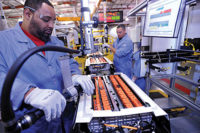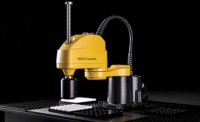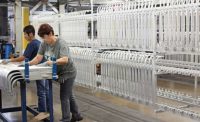The United Nations has proclaimed 2015 to be the International Year of Light. The global initiative is designed to highlight the key role that light and optical technologies play in daily life.
Today, a quarter of the electricity generated worldwide is needed to illuminate factories, office buildings, homes, hospitals, schools and streets. However, many applications still use traditional lightbulbs, which convert only 5 percent of the electricity they receive into light; the rest dissipates as heat.
Light-emitting diode (LED) technology is revolutionizing the lighting industry. LEDs use only 75 percent of the electricity required by incandescent bulbs, but they last 300 times longer and generate 90 percent less heat.
Next-generation lighting products rely on a small electronic chip. Whenever a current is passed through it, the electrons in the chip become excited and emit the energy as light. Three quarters of the electricity is converted into light and LEDs last up to 30,000 hours. In addition, color and brightness can be digitally controlled.
Demand for commercial, industrial and residential LED lighting applications is skyrocketing. However, producing LED fixtures and luminaires can be challenging and complex, because of the large amount of circuit boards, sensors and other sensitive electronic components.
Growing Demand
At the recent Lightfair International trade show in New York City, LED technology took center stage. Exhibitors unveiled hundreds of advanced products, including bulbs, electronic components, controls and optics.
“LED prices have declined to a point where this type of lighting is becoming the economical choice in almost every application,” says Jesse Foote, senior research analyst at Navigant Research. “While early adopters sought some of the unique features of LED lighting, such as improved efficiency, improved operation in cold environments and enhanced controllability, the current wave of adoption is much more focused on the value of ongoing energy savings compared to a modest increase in upfront cost.”
According to Foote, global unit shipments of LED lamps and modules are expected to grow 19 percent annually over the next decade.
“This growth presents many [new opportunities], but significant challenges are also arising,” warns Foote. “The fall in LED prices is leading to the commoditization of many LED components, fueling price wars. Meanwhile, patent disputes are increasing as the owners of intellectual property protect their turf.”
This is putting pressure on traditional lighting manufacturers, such as General Electric, Osram and Philips, which are paranoid about protecting proprietary production processes. But, it has also opened up new opportunities for a variety of start-up companies, such as Bridgelux, Cree, Ketra and Soraa.
“The phase out of incandescent lights has begun, and the onset of LED command of the market is upon us,” claims Susan Eustis, president of WinterGreen Research Inc. “The emergence of cost-competitive LEDs has caused a paradigm shift in the lighting industry that has changed everything.
“Rapid technological change has been brought by enormous changes in the regulations affecting lighting,” explains Eustis. “Short product lifecycles are a result of new manufacturing methods and materials that are the result of companies trying to improve the economies of scale to make price points more attractive to customers.
“Frequent product introductions have characterized the LED lighting industry,” adds Eustis. “There is a highly competitive pricing environment, with the current price point of $6 per light about to decline further, creating competitive changes in the lighting markets.”
The LED revolution has forced some old-school electrical equipment manufacturers to alter their assembly lines.
“Our balance of production is now around 85 percent LED, and this is growing annually,” says Adam Rice, marketing manager at Urbis Schreder Ltd., a leading manufacturer of outdoor lighting products, such as street lights and floodlights. “Our high-intensity discharge (HID) products are slowly being phased out. We anticipate 100 percent LED production within the next few years.”
Five years ago, Rice says the ratio was almost the opposite, with HID dominating the market. “As with any new technology, people were understandably cautious of LED and needed time to absorb, understand and embrace it before making an informed decision on whether or not they preferred it,” he points out. “This has definitely now happened. The LED boom has started and, as a result, more companies are trying to establish themselves in the market.”
Another manufacturer that has rapidly shifted production to LED technology is LaMar Lighting Co. Until recently, the company specialized in fluorescent lighting fixtures.
Today, the second-generation, family-owned firm is focusing on bi-level lighting systems, which are typically used in commercial and industrial washrooms, stairwells, hallways, conference rooms and other settings that are not always occupied. They feature ultrasonic motion sensors that are built into the fixture. Unlike many other companies, LaMar still assembles 95 percent of its products in the United States.
“The market is getting flooded with fixtures and bulb replacements [with questionable quality], mostly from Chinese factories,” claims Jeff Goldstein, CEO of LaMar Lighting. “Many lighting companies selling into the U.S. market are nothing more than distributors or resellers of imported products. Those ‘manufacturers’ are relative unknowns or are not experienced in the industry.
“There are many new trends today, including bulbs and fixtures that feature adjustable color temperatures, wireless networking capabilities and Bluetooth control,” notes Goldstein, who has been in the lighting industry for more than 30 years.
One of the newest trends in the residential market is smart lighting. The Internet-connected lightbulbs can be remotely controlled with a mobile phone or a tablet device.
“Many of these products are gimmicks or toys for ‘early adopters,’” claims Goldstein. “They have very little actual purpose for the long term.”
However, LED technology does give engineers the freedom to do much more than they ever could with traditional lighting products. For instance, lighting can now be built into street furniture, such as hand rails, park benches or bus shelters. It can also be integrated into architectural features on buildings and bridges.
“We are now seeing these types of projects becoming increasingly popular with architects and designers, due to the depth and variety it can add to a lighting project,” says Rice. “LED also allows a great deal of flexibility in controlling the light.”
For example, traditional HID cannot be dimmed due to the warm up phase, whereas LED has an instant lux level the minute it is activated. “This means lighting levels can be controlled with precision via switches or sensors, such as passive infrared,” explains Rice. “It also means digital multiplex systems can be connected to control interactive color-changing LED displays.”
Complex Components
There’s more to LED lighting than just a bulb. Key components used in fixtures and luminaires include drivers, circuit boards, wires, connectors, end plates, diffusers and heat sinks, in addition to brackets, screws and other mounting hardware
“Instead of a filament, LED lights use a chip, and instead of a ballast, there is a driver,” says Alfred Heyer, CEO of Photonic Labs, an engineering company that designs and manufactures cutting-edge solar and LED technologies.
According to Heyer, the key to extending the performance and life of an LED product is to disperse heat quickly. Engineers focus their attention on providing the right type of heat sinks and improving air flow. Fixture design has to take into account thermal management, because LED quality is directly correlated to heat.
Electrostatic discharge is another thing that engineers must take into consideration, especially during the assembly process. And, since LEDs are very bright and point light sources—they produce a narrow field or focus of light, not a wide field—optics and diffusion are more critical than in traditional lighting products.
“An LED chip is a solid-state semiconductor,” explains Pervaiz Lodhie, president of LEDtronics Inc., one of the only companies that produces LED bulbs and lamps in the United States. “It must be driven under highly controlled voltage and current conditions.”
While LEDs are cool to the touch on the front surface, they get very hot on the back side. Heat is the No. 1 enemy of LEDs.
“The operating temperature of the LED chip must be controlled under all surrounding temperatures and external environment temperature conditions,” Lodhie points out. “This has created a vibrant, growing industry for LED drivers, heat sinking devices and long-life miniature fans, in addition to metal castings for housings, shells, mountings and brackets.”
“LED products are not necessarily more complex than traditional lighting, because they work with similar principles,” adds Rice. “For instance, they still require control gear, surge protection and photocells.
“Things become slightly more advanced when you add in passive infrared sensors or programming,” says Rice. “When each lighting unit can communicate with others, there is more technology connected to the actual luminaire that needs to be considered.
“The complexity of LEDs is their inherent vulnerability,” Rice points out. “LEDs are extremely efficient, yet extremely delicate.”
According to LaMar Lighting’s Goldstein, LED fixtures and luminaires are more challenging to assemble than traditional incandescent or fluorescent products. “A typical fluorescent fixture has a ballast, wiring and sockets,” he explains. “Many of the ballasts come with wires attached. This is a fairly simple assembly: push the wires into the proper sockets, mount the sockets and you’re basically done.”
However, Goldstein says LED wiring is much more complicated. For instance, LED drivers either have no wire or very short leads, so wire has to be added, and connections must be made based on the wiring schematic, which can vary based on factors such as specific LED boards, drivers, desired light output and drive current.
“Many LED systems can be wired parallel, in series or a combination of the two,” says Goldstein. “Miswiring can have detrimental results. LED boards must be properly fastened with screws, rivets, special push-in connectors or double-sided tape.
“Many drivers are programmable, with special equipment,” adds
Goldstein. “Selecting the proper parameters is based on the wiring type and desired output. Wrong programming can cause board failure.”
Assembly Challenges
LaMar Lighting produces more than 200 types of linear lighting products with multiple variations within each product type. It relies on flexible assembly lines and operators who thrive in a low-volume, high-mix production environment.
“We have five assembly lines, and most of our production is short run, varying anywhere from one to 500 pieces,” says Goldstein. “We build multiple products on the same lines.
“Our production is focused on the ability to handle short runs, so we have a dedicated staff and procedures to ensure that the transition from one product run to another is almost seamless,” Goldstein points out. “Raw materials for the day’s production are staged at the head of each assembly line and as soon as the last part is started on the line, the next item up for production is then started.
“It is quite common to have two to four different items in varying stages of assembly on any one particular line,” notes Goldstein. “This enables us to produce many item types in an expedient manner. Each assembly line is headed by experienced production wiring specialists, and four to eight assemblers.”
They use pneumatic vertical screwdrivers, crimping tools, and blind riveting tools. “We do not solder and typically don’t use adhesives except for gasketing on some products,” says Goldstein. “Many of our fixtures include integrated controls, battery backup and other technological enhancements. We also fabricate most of our sheet metal housings in house.”
Changing over from producing fluorescent fixtures to LED products over the last three years has required extra training and adaptation.
“Building fluorescent fixtures is relatively simple,” claims Goldstein. “Assemblers are now handling circuit boards and other electronic components that they never had to handle before. These components must be mounted a certain way to ensure proper contact, and assemblers must avoid overtightening.
“Today, we’re dealing with much smaller connectors, screws and other components than we did in the past,” notes Goldstein. “Our assemblers are used to operating pneumatic screwdrivers to build sheet metal parts and larger components. They’re also inserting and driving more fasteners than ever.
“To produce one of our products, we typically use a 22-inch-inch long board with a single row of LEDs down the middle,” explains Goldstein. “To replace a typical three-bulb fluorescent fixture with LEDs, we have to fasten six boards to the fixture and interconnect where the boards meet. We use an average of four fasteners per board. So, that’s 24 fasteners per LED fixture vs. two fasteners to hold the ballast in a fluorescent fixture.”








